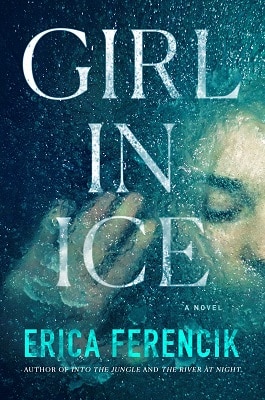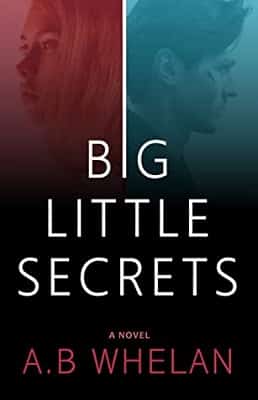
Q&A
Erica Ferencik
Oprah chose Erica Ferencik’s debut novel, The River at Night as a #1 Pick, calling the book “the page-turning novel you’ve been waiting for, a heart-pounding debut.” Entertainment Weekly named it a “Must Read,” and calls the novel “harrowing…a visceral, white knuckle rush.” Miramax has recently optioned the novel for a film.
Her work has appeared in Salon and The Boston Globe, as well as on National Public Radio.
Q. In Girl In Ice, a girl is found, frozen in the ice. When she thaws, she speaks a language no-one understands. What first brought this idea to you?
Erica: One bitterly cold morning in the winter of 2018, I was walking in the woods near my home, and came upon what looked like juvenile painted turtles frozen mid-stroke in the ice along the shallow edge of a pond. They didn’t look alive, but they didn’t look dead either.
It turns out there are some animals (and plants too!) that have this freezing-and-coming-back-to-life thing down. Painted turtle hatchlings, some species of beetle, wood frogs, certain alligators, even an adorable one-millimeter length creature called a Tardigrade or “water bear” that can be frozen to -359C and thaw out just fine. Most of these creatures possess a certain cryo-protein that protects their cells from bursting when they freeze.
A protein that…we don’t possess. Still, the image of a young girl frozen in a glacier in the Arctic popped into my head. From there, I asked myself: How did she get there? What was her story?
Q. You’ve done an incredible amount of exotic travel. What’s the craziest place you’ve been?
Erica: Crazy things happened on a daily basis, but there were times on each research trip where I had to grapple with my fear and find my way through it.
I spent three weeks in the Allagash Territory in Northern Maine, in the winter, to do research for The River at Night. By making dozens of someone-who-knows-someone phone calls, I cobbled together interviews with people who had disappeared themselves from society. One guy would only agree to an interview if I met him at certain mile marker on a remote logging road. He arrived on horseback. At that point I had to decide: am I going to get on the back of this guy’s horse and ride with him a mile through the woods to his home, his condition for letting me conduct an interview? Am I insane? But I reminded myself: I had vetted this guy. Several people knew where I was and when to expect me to call after this interview. And I always had my mace. And so, off we went, galloping through the woods. It was one of the best interviews I got.
Only once during the weeks I spent in the Peruvian jungle with my guide – a native and a hunter – did I see him spooked. The plate-sized jumping pink-toed tarantula, the herd of peccaries thundering our way, the troop of howler monkeys who had decided to pelt us with their poop – none of it phased him. It was during our night ride in a dugout canoe through the floating forest – anacondas coiled in the trees above – when it happened. By headlamp – probably disturbed by our boat – a six-foot electric eel leapt out of the water, coiling and snapping, and splashed back down. One touch from this thing can stun a horse. That’s when I caught a flash of fear in my guide’s normally serene demeanor. Quickly he rearranged his face and said, “I wasn’t expecting that.” I thought: he’s keeping his cool, I’m going to stay cool too…
In Greenland, a small band of explorers and myself kayaked with our native guide into a section of a fjord known as the Iceberg Graveyard, where – because of quirks in ocean currents – thousands of giant ice floes gather until summer, when most melt away. All around us, jaw-droppingly strange bergs loomed only hundreds of yards away. Some soared ten stories high, all carved into impossible shapes: eerie cathedrals, massive arches, a bulbous monster two city blocks long, scored and warped by the waves. I asked my guide what would happen if one of these split or calved. He said we’d all have to turn our kayaks toward the sound – fast – in order to keep from being flipped into the icy waters by the mammoth waves that would form. Heart pounding, I thought what am I doing here, then took my cue from the others, each of them calmly gliding along between the ice monsters, listening.
Q. One of the themes that runs through your work is of strong women overcoming insurmountable obstacles. Are there any obstacles in your life that have provided writing fodder?
Erica: I could speculate all kinds of deep psychological reasons for my love of survival stories. Let me put it this way: like so many others, I survived an extremely challenging childhood, and so I have ready access to dread, to feeling trapped, to planning creative ways to survive. In short, my fight or flight hormones are quite close to the surface. So…what’s my deal…PTSD? Repetition compulsion? Guesses are welcome! Simply put, I love any great story no matter where it’s set; however, I’ve got a soft spot for stories of survival where the setting is an element to be reckoned with.
In terms of where material comes for stories: it’s gleaned from every moment of being alive – beautiful moments, eerie ones, unexpected ones. I tell my writing students to never feel bad about doing things that are not writing. I ask them, Where do you think story detail, emotions, characters, dialogue, plot twists come from? It all comes from drinking too much at the party, from the unfathomable pain of rejection by a lover, by incomprehensible grief, by loss, empathy, adopting that dog, that kitten, that chance encounter at the park, by holding your dying grandmother’s hand, or just how you felt this morning after that first sip of coffee. Everything that can be lived and observed is important in a writer’s life.
Q. You spent a decade doing stand-up comedy. How does humor impact your writing?
Erica: Since humor is part of being human, it’s part of the world of story, too. You may not notice it much, but a novel completely devoid of humor – even thrillers – will feel stiff and strange. You’ll even find the occasional funny quip in horror novels especially, since it serves to break the tension, in order to – ironically – ramp up the dread even higher.
But comedy helped me in my younger years in other ways. They say that comedy is the angry art. And it’s true. As long as you’re funny, you get to go up there and rail against what you perceive as unfair, wrong, absurd, and so on. There is a lot of darkness in comedy. In fact, I defy you to tell me an actually funny grownup joke without a dark, or tragic, or sad kernel. Jokes about happy things aren’t funny. This is why people love comedy: someone, up there onstage, is calling out things that have bothered them or pissed them off for decades, but they didn’t know how to articulate it.
Back when I was doing stand-up or sketch comedy, I was a frustrated writer with several terrible novels in my drawer, but with a hunger to be seen and heard. Getting up on stage and letting it rip was instant publication: immediate feedback. It taught me to think on my feet. It taught me discipline: you had to come up with new jokes all the time.
Comedy demands keen powers of observation. If you’re not paying attention, taking notes about what you see, hear, feel, then take the second step and ask yourself, why is this funny, how can you come up with material? Never mind asking yourself how can I process this through the lens of who am I as a comic? But the first step is always: observe.
Which is also a crucial skill for a novelist.
Bravery is a muscle we all exercise every day, especially these days, but doing stand-up was where I practised bravery, night after night, for years. It took me a while to really grok that comedy isn’t one-way – you’re not just dumping jokes on people – it’s a conversation with the audience. After every joke, you must give your audience a chance to react. If you don’t, they will sense your fear and eat you alive.
People ask me these days: Weren’t you frightened, kayaking between massive bergs, knowing if they calved or split, waves could hurl you into thirty-degree water? What about the giant anacondas coiled in the branches over your canoe as you threaded through the floating forest by moonlight? I would say that for all those scenarios you can lower your risk: you can find a great guide, wear the right gear, pack a machete of your own. But try standing in front of five hundred people waiting for them to laugh at a joke that seemed hilarious in the shower that morning. That has to be the scariest journey of all.
Q. What are you working on now?
Erica: I’m afraid that’s a bit under wraps at the moment, but I can tell you that it’s an eco-thriller that poses the question: what happens when nature strikes back at humankind’s attempts to destroy it? The protagonist must somehow answer the second question: how do you defeat an enemy you desperately need for your own survival?
Erica Ferencik's Latest
Girl In Ice
Valerie “Val” Chesterfield is a linguist trained in the most esoteric of disciplines: dead Nordic languages. Despite her successful career, she leads a sheltered life and languishes in the shadow of her twin brother Andy, an accomplished climate scientist stationed on a remote island off Greenland’s barren coast. But Andy is gone: a victim of suicide, having willfully ventured unprotected into 50 degree below zero weather. Val is inconsolable—and disbelieving. She suspects foul play.
When Wyatt, Andy’s fellow researcher in the Arctic, discovers a scientific impossibility—a young girl frozen in the ice who thaws out alive, speaking a language no one understands—Val is his first call. Will she travel to the frozen North and meet this girl, try to comprehend what she is so passionately trying to communicate? Under the auspices of helping Wyatt interpret the girl’s speech, Val musters every ounce of her courage and journeys to the Artic to solve the mystery of her brother’s death.
The moment she steps off the plane, her fear threatens to overwhelm her. The landscape is fierce, and Wyatt, brilliant but difficult, is an enigma. But the girl is special, and Val’s connection with her is profound. Only something is terribly wrong; the child is sick, maybe dying, and the key to saving her lies in discovering the truth about Wyatt’s research. Can his data be trusted? And does it have anything to do with how and why Val’s brother died? With time running out, Val embarks on an incredible frozen odyssey—led by the unlikeliest of guides—to rescue the new family she has found in the most unexpected of places.
More Thrillers
Advertisement
Thriller Features
Myth and Thrillers
Ancient Legends and Modern Plots
Hiding Bodies
The sinister act of hiding bodies in thrillers
Morally Compromised Thrillers
Right, Wrong, and Everything in Between










